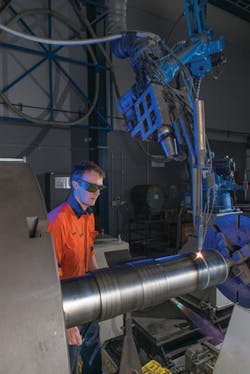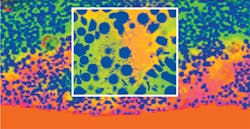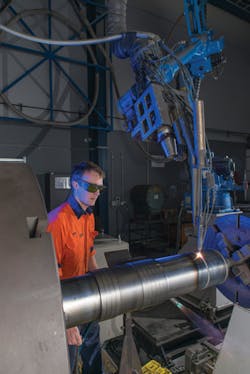Deposition process redesigns high-wear components
ALLAN MORTON
Since its establishment in 1993 (initially as HVOF Australia Pty Ltd), LaserBond has concentrated on research, development, and implementation of advanced surface-engineering techniques to dramatically reduce the wear rates, maintenance, and operating costs of production-vital components. It manufactures, repairs, reclaims, and enhances the performance of high-wear-critical metal components in a range of capital-intensive industries—particularly mining, where equipment constantly operates in a variety of highly abrasive and uncommon wear conditions.
With a staff of 60, the company serves a variety of industries in addition to mining, including metal refining and smelting; power generation; road and rail transport; aerospace and gas turbines; shipping; valves and fluid handling; and oilfield drilling and exploration.
Laser deposition development
A precursor to LaserBond's recent growth was its development of a patented laser deposition process. This research work, led by founder and executive director Greg Hooper, was directed towards enabling high deposition rates of typically hard-phase metallurgy, with minimal debilitating impact on the substrate and overlay.
"Our method enables the laser deposition of metallic or metal matrix composite (MMC) layers with a full metallurgical bond by utilizing an accurately focused, infinitely controllable, high-power laser beam supported in a multi-axis robot and integrated with a separate multi-axis workpiece platform that enables precise control of heat transfer into base material and the deposited layer," Hooper explains. "Our integration enables the repair of temperature-sensitive components and materials, such as hardened shafts and gears, with minimal risk of distortion or other undesirable heat effects that undermine the integrity of the component or in-service performance. This method enables the deposition of MMC overlays with significantly smaller hard-phase particles, with minimal heat effects. The concentration of hard phases can be significantly increased and dramatically improved distribution achieved with the new method. Therefore, the mean free path between the WC (tungsten carbide) particles is smaller and wear resistance is considerably improved."
Synchrotron images (FIGURES 1 and 2) illustrate the results of this deposition technology that has created opportunities for redesigning high-wear components. The key advantages offered over other methods are:
- High deposition rates;
- Extremely low dilution with base material, enabling very thin layers;
- Almost nonexistent heat-affected zones, eliminating the effect on structural performance of substrates; and
- Negligible distortion, enabling cladding of dimensionally sensitive components.
A unique feature of LaserBond is its scientific approach and understanding of the bonding mechanics and resultant metallurgy of the cladding. In 1995, the company invested in an in-house laboratory featuring a scanning electron microscope for investigating coatings and metallurgy down to the nanoscale. The lab is routinely used for optimizing coatings and overlays, quality control of incoming materials, reports to clients on new applications, and materials and failure analysis as required.
The company's Down-the-Hole (DTH) drilling hammer product is a direct outcome from the new deposition method. Comprehensive independent tests proved this extended hammer wear life by 305% (over 3X), coupled with a significant 7.5% reduction in total mine-site drilling costs.
Keys to success
Company chairman Allan Morton emphasized three areas of unmatched expertise within the resource industry. "We know a lot about tribology…in particular, the mechanisms of wear in extreme mining, drilling, and mineral processing environments and their cost implications. The second key thing is advanced metallurgy. We're very good at developing a cladding for a specific duty. Knowing our customer's application and the wear characteristic occurring—say, in a slurry pump or percussion drill or inside a continuous underground miner—we tailor an alloy specifically for that. The third is our extensive understanding of the cladding application process—the ability to specify the right method and laser parameters."
For 25 years, LaserBond has self-funded its R&D efforts in surface engineering and the application of lasers. The company's recent collaboration with the University of South Australia's Future Industries Institute (UniSA) to develop wear-life technologies for mining is set to elevate new knowledge in wear mechanics and application of laser cladding technology. The Australian Ten Year Sector Competitiveness Plan for the mining equipment, technology, and services (METS) industry provides a roadmap to increase global competitiveness; it specifically focuses on facilitating collaboration between METS companies and researchers. The company is being supported with grants that multiply its R&D activities.
"When you add industry collaboration or strategic partnering together, you're shifting the relationship—you're not a vendor and you're no longer perhaps a key supplier—you're pioneering things together, you're partnering, you're in a mutually beneficial alliance," Morton says. "It opens a huge opportunity. And that's why I believe the Australian Government's Department of Innovation and Science, and our South Australian Department of State Development, have done a great job facilitating and supporting our laser technology R&D, and assisting with our next-generation laser cladding system development."
Technology licensing
LaserBond now licenses its laser cladding technologies as customized turnkey systems in custom hardware, software, and support packages. The packages involve design, building, installation, and commissioning of a laser cladding cell tailored to a customer's specific applications, and incorporate fiber-coupled diode lasers in configurations from 4 to 10kW. For future work, the company is installing a 16kW unit in its advanced manufacturing and research facility in Adelaide. Cladding head positioning is provided by a six-axis robot selected for high stability and control at extended reach. The company also designs and manufactures its own multi-axis workpiece positioning system, with capacities for up to 20-ton components (FRONTIS) with a swing up to 2 and 9m in length.
Executive director Wayne Hooper describes the proprietary powder injection nozzle system: "Cladding large mining industry components requires extended running times at high power levels, with some projects running 16 hours at maximum power. This requirement led us into developing our own water-cooled, off-axis powder injection nozzle. This incorporates a rapidly replaceable powder injection tube and gas depressurized gravity-fed powder mixer. The geometry of the part being processed determines parameter settings for the nozzle. This led us to invest in our own control system development."
Achievements
LaserBond has been awarded a $2.6 million government grant for wear-life extension via surface-engineered laser cladding for mining projects. The LaserBond-led project, which involves UniSA and global drilling equipment manufacturer Boart Longyear as project partners, received funding to support the three-year collaboration associated with the material science and use of its technologies to improve a spectrum of wear points, many associated with drilling for mining.
Coincidentally, LaserBond and Boart Longyear recently signed a non-binding strategic partnership to pursue mutually beneficial commercial products and services. UniSA and LaserBond already have a collaborative R&D agreement for development of technology, systems, processes, and applications associated with wear-resistant, surface-engineered cladding for resource, agricultural, and other heavy industries.
LaserBond has signed a technology licensing contract with a large minerals-processing equipment manufacturing and repair company in Asia, which initially involves design, building, installation, and commissioning of a laser cladding cell tailored to the company's specific applications. "We have chosen a company that has demonstrated ability to partner with international technology companies, and which has a large presence in its mining equipment market," Wayne Hooper says. "The contract demonstrates the significant value in the technology and intellectual property that LaserBond has developed. We are aiming to make this agreement the first of many."
As mentioned above, LaserBond's new DTH Hammer lasted more than three times longer than the industry standards that it was competing with at a comparative trial in Southern Australia. Under sole control of Brisbane-based mining consultancy Xtega Pty Ltd., this independent comparative trial was held at a hard-rock metalliferous mine, selected for its highly abrasive rock with an indicated megapascal (MPa) between 90 and 200. "There is an irrefutable decrease in the rate of abrasive wear, which results in a 305% increase in the life of the LaserBond hammer," Xtega concludes. Other benefits included improved mechanical availability and efficiency; higher impact and penetration rates; improved site and operator safety; and less downtime for changeouts, along with significant 7.5% cost savings.
An underground coal shearer reports 10X longer wear-life with LaserBond's laser cladding technology added to an off the shelf component. "Without our attention, these units only last 40-60 hours of operation before the hard rock inclusions wear through into the water cooling system and render the unit useless. Now, our customer is looking to save millions," Greg Hooper explains, after inspecting onsite performance.
What the future holds
In 2016, LaserBond experienced commercial success, including 240% growth in export sales from its development of new products and customers, both domestic and international. Morton says the company was on track for a forecasted 30% growth in 2017 and, in coming years with investment in its next-generation advanced laser cladding technology cell, will open more doors to OEM customers with greater cladding performance demands on larger products.
"There's no absolute on the future—you just position yourself as best you can until you get there," Morton says. "Our strategic international relationships are growing on the supplier side and customer side. We are delivering for companies who are seeking high-performance wear resistance in particularly tough situations. LaserBond excels when working in strategic partnerships. As an example, we designed a machine tailored for an international company that makes a 10-ton crusher roller, which allows them to refurbish it."
ALLAN MORTON([email protected]) is the chairman of LaserBond, Smeaton Grange, NSW, Australia; www.laserbond.com.au.



